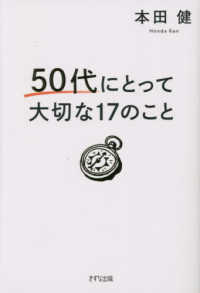- ホーム
- > 洋書
- > 英文書
- > Politics / International Relations
Full Description
This comprehensive analysis documents the military forces in each Middle Eastern country at the end of the Cold War. Cordesman discusses security developments and provides a qualitative and quantitative analysis of the strength and effectiveness of every army, navy, air force, and air defence force in the region. He further assesses post-Cold War modernization and expansions plans and each country's internal security situations, the role the military plays in its government and internal tensions and civil wars. Special attention is paid to Iran and Iraq and the author examines the military changes in both countries as responses to the Iran-Iraq and the First Gulf War.
After the Storm is unique in combining the evaluation of conventional forces with assessments of developments in biological, chemical and nuclear weapons and provides a coherent picture of the state of the military in the Middle East in the early 1990s. Summary tables and charts present keys statistics for the region, formatted to allow quick country by country comparisons.
Contents
1. Weighing the Military Balance in the Middle East
The Casualty Effect
The Burden of Military Expenditures
Trends in Military Manpower
Equipment Numbers: The Issue of Quantity
Force Quality and Continuing Weaknesses in Middle Eastern Forces
2. Arms Transfers to the Middle East
The Total Flow of Arms to Individual Middle Eastern Countries
The Role of Arms Suppliers
Arms Costs versus Flows of Weapons
Supplier Relationships with Individual Middle Eastern States
The Role of Military Advisors
3. Trends in the Proliferation of Weapons of Mass Destruction
The Impact of Long Range Missile Systems
The Impact of Chemical Weapons
The Impact of Biological Weapons
The Impact of Nuclear Weapons
The Technology and Practice of Proliferation
4. Trends in the Military Balance and Arms Sales in North Africa
Patterns in Arms Imports and Military Advisory Efforts
Mauritania
Morocco
Algeria
Libya
Tunisia
5. Trends in the Military Balance and Arms Sales in the Arab-Israeli Confrontation States
The Economic, Demographic, and Military Forces Affecting the Arab-Israeli Balance
Israel
Syria
Jordan
Lebanon
Palestinian Forces
Egypt
6. Trends in the Military Balance and Arms Sales in the Northern Gulf States
The Impact of Iran and Iraq on the Regional Military Balance
Iran
Iraq
7. Trends in the Military Balance and Arms Sales in the Southern Gulf States
The Gulf Cooperation Council and Efforts at Collective Security
Saudi Arabia
Kuwait
Bahrain
Qatar
UAE
Oman
8. Trends in the Military Balance and Arms Sales in the Red Sea and the Horn
Yemen
Sudan
Ethiopia
Djibouti
Somalia
9. Strategic Interests, Arms Control, and Regional Stability: Conflict or Synergy?
The Problem of Peace Negotiations
The Problem of Arms Control
The Problem of Military Build-ups
The Rule of Law and the Illusion of Democracy
Security Problems of the Middle East and Southwest Asia: A Selected Annotated Bibliography
Index








